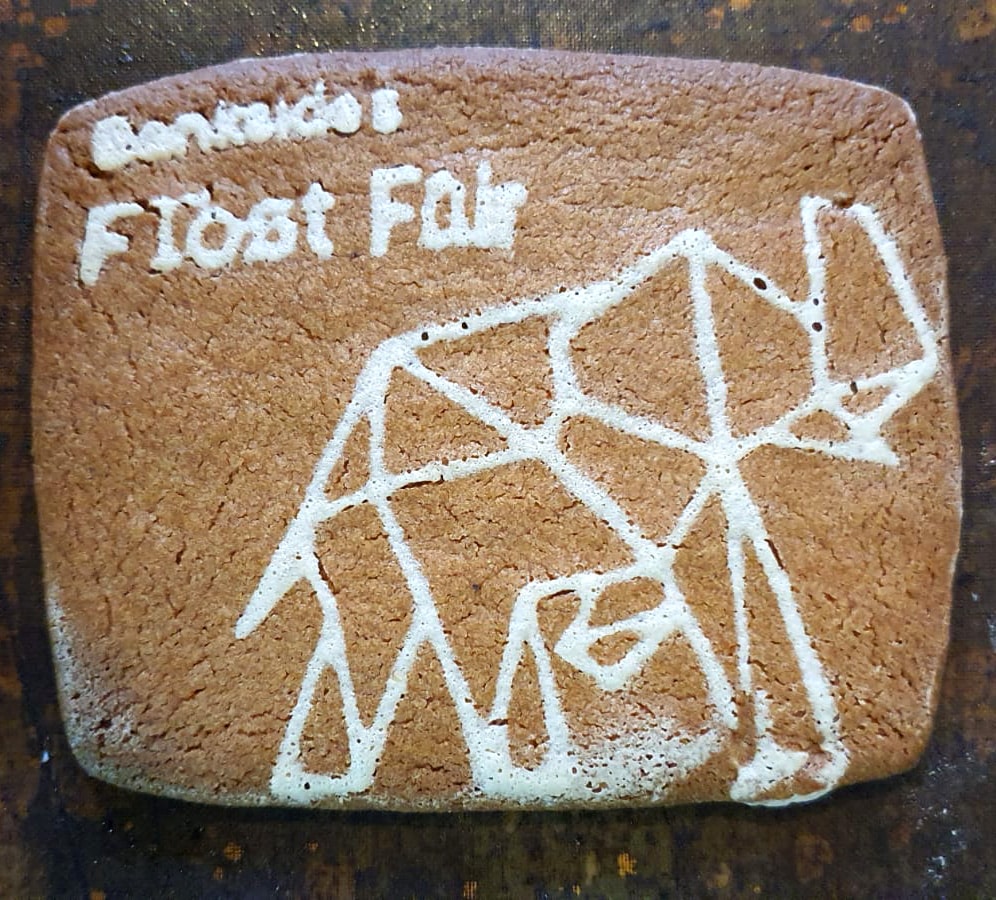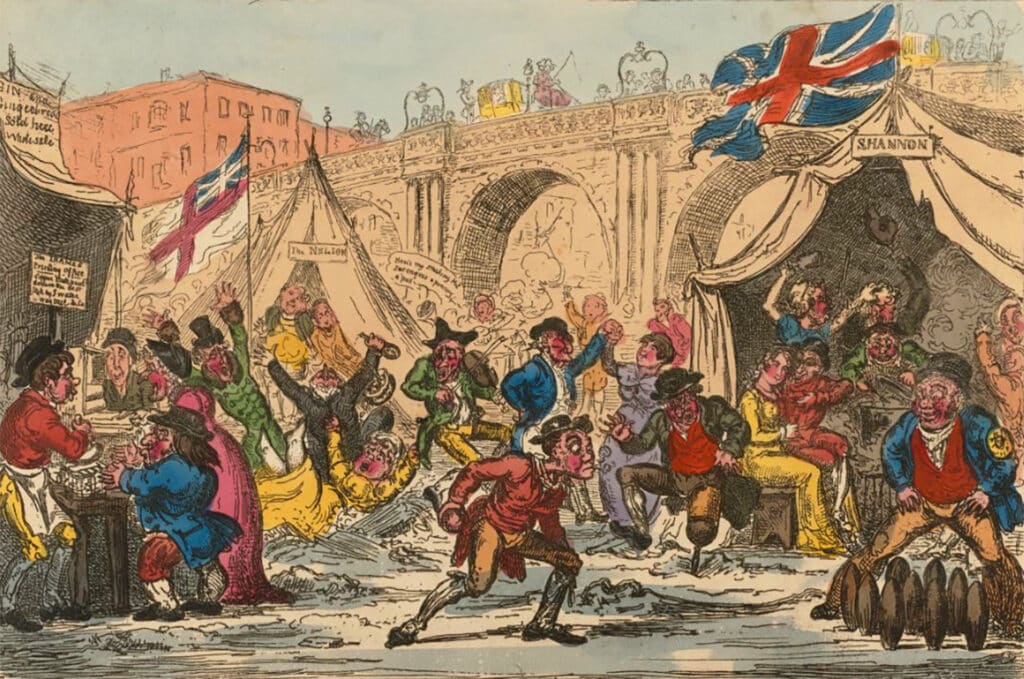Frost fare
The food and drink of the Frost Fairs and where to find it in today’s Borough Market


“JUST BECAUSE WE CAN’T SLIDE AROUND ON THE RIVER LIKE FROST FAIR REVELLERS DOESN’T MEAN WE CAN’T EAT AND DRINK LIKE THEM”
A major appeal of the Frost Fairs – the spontaneous festivals that erupted on the frozen Thames between the 16th and 19th centuries – was the party food sold by traders out on the ice. Climate change means that the river will probably never freeze again, and even if it did, we can assume that modern standards of health and safety would prevent any such revelry. But just because we can’t slide around on the river like Frost Fair revellers doesn’t mean we can’t eat and drink like Frost Fair revellers – and to do that, Borough Market is the perfect place to start.

Beef
A Frost Fair simply wouldn’t have been a Frost Fair without large hunks of meat roasting over open fires. Whole pigs and sheep were fairly commonplace, but the real star of the show was usually an ox, driven down from Smithfield Market, dispatched with great ceremony by a butcher wearing “a laced cambric apron, a silver-handled steel, and a hat and feathers”, then spit-roasted whole for days on end – an incredible spectacle and proof of the extraordinary solidity of the ice. Borough Market isn’t the place to come for either a live ox or a whole beef carcass, but at Wild Beef, Ginger Pig and Northfield Farm you’ll find magnificent roasting joints large enough to feed a multitude. Most importantly, the animals they come from will have lived a happy life grazing on pasture, much like those of yesteryear.
Gin
Let’s be honest: the Frost Fairs, while also a venue for shopping, sport, music, theatre and dance, were largely an excuse for Londoners to get completely lashed. “As many tuns of ale and brandy flow / Above the ice, as waters do below,” wrote one wit. In contemporary sources there are mentions of beer and ale, purl (ale infused with wormwood), canary and sack (two names for sweet Spanish wines), brandy and rum. This being London, though, gin was the thing. Imagine Hogarth’s famous Gin Lane print, but with the steps of St Giles replaced by an ice sheet. Borough’s East London Liquor Co. is among the finest of London’s current crop of gin makers and while theirs is a drink markedly less rough than anything that would have been sold on the ice, it’s no less capable of fueling a party.

Gingerbread
From first until last, gingerbread was a staple treat of the Frost Fairs. In 1814, it was among the three consumables (together with gin and beer, inevitably) that one observer noted as having “a plentiful store” among the event’s vendors. Sweetened with honey or sugar and packed with candied fruits and exotic spices, the gingerbread of the past would have been deeper, denser and more cake-like than the biscuits we now associate with the name. The Cinnamon Tree Bakery has produced a special gingerbread to mark the Frost Fairs, emblazoned with an elephant illustration in honour of the (almost certainly mythical) appearance of an elephant on the ice. Handmade in Camberwell, these beautiful biscuits are flavoured with the same wintery spices that the Frost Fair bakers would have employed in their craft: nutmeg, mace, cinnamon and cardamom as well as ginger.
Coffee
If the weather’s cold enough to freeze the Thames solid, you’re definitely going to want a hot drink. Coffee was a regular staple of these impromptu festivals, as were tea and hot chocolate. At the time of the 1684 Frost Fair, coffee was incredibly fashionable. London’s very first coffeehouse had opened in 1652, sparking a surge in demand for this bitter Arabian decoction. In 1675, Charles II made an ill-fated attempt at banning its sale, believing that cafes were magnets for political malcontents, but when the King appeared at the Frost Fair nine years later, the drink was all the rage. Within a century, coffee’s popularity would be overtaken by that of tea, but it has recently regained its status as London’s chosen source of caffeine. Borough Market is home to the very best of this magical bean’s importers and roasters, including Monmouth Coffee Company, The Colombian Coffee Company and Change Please.
Cheshire cheese
In accounts of the Frost Fairs, there are several mentions of bread and cheese being sold – and specifically Cheshire cheese. In the 17th and 18th centuries, cheesemakers from Cheshire absolutely dominated the London market. Cheshire was the English cheese, in the way that cheddar is today. But whereas once the northwest was home to hundreds of producers of raw milk, clothbound, farmhouse Cheshire, today there’s just one: Appleby’s. Sold by Neal’s Yard Dairy, Appleby’s Cheshire has the same juicy acidity and characteristic crumble that ice-bound Georgian cheese lovers would have enjoyed, if they could really taste anything after all that gin.

Pies
The pie has been one of the cornerstones of English cuisine since long before the Frost Fairs. Filling pastry with meat or fruit is something we can’t help but do as a people, like playing ball sports and drinking to excess. Just as it was absolutely inevitable that drinking sessions and games of football would break out on the ice (“And football playing there was day by day, / Some broke their legs, and some their arms they say,” wrote one poet in 1684), so too was it completely assured that piemakers would find a brisk trade among the revellers. The very same would no doubt happen today. Pieminister’s Kate and Sidney pie, filled with generous amounts of steak, kidney and ale – a proper cold-weather soul warmer – would be the perfect place to start.

Dancing on ice
Mark Riddaway tells the remarkable story of the Frost Fairs, a heady tale of food, festivities and the occasional disaster